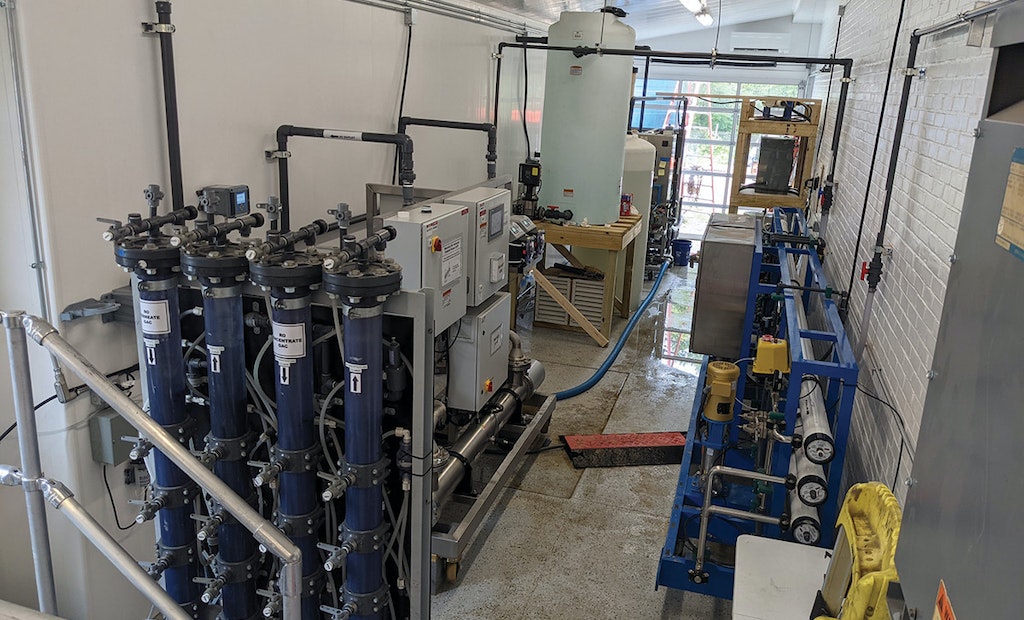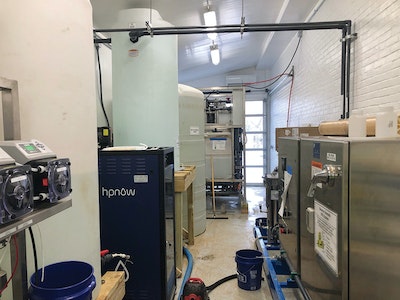
The PUREWater Westminster pilot project is a 20 gpm version of what the city hopes will become Maryland’s first indirect potable reuse project. The goal is to supplement the city’s water supply with up to 1 mgd.
Interested in Recovery/Reuse?
Get Recovery/Reuse articles, news and videos right in your inbox! Sign up now.
Recovery/Reuse + Get AlertsIn drought conditions the city of Westminster sometimes has to impose lawn watering or other restrictions. But that’s not the reason the city is developing the state’s first indirect potable reuse project to supplement its water supply.
“We have enough water that we can provide everything we normally need to, but we can’t grow anymore,” says Mark Mellendick, assistant superintendent of the Westminster (Maryland) Water Reclamation Facility.
To provide enough water to accommodate growth, the city hopes to pipe up to 1 mgd of highly treated effluent from the reclamation plant upstream to the reservoir that is the main source of water. The project is named PUREWater Westminster, and a pilot ran for about nine months in 2021-22. The city has been approved by the state Department of the Environment to begin design and then construction, expected to begin in late 2023.
PIPE IN PLACE
A 14-inch pipe to carry the effluent back to the reservoir is already in place from a project that began in 2005, not long after a drought temporarily dropped water capacity to below demand. “We actually started trucking water in,” Mellendick says.
A 6.5-mile pipeline connects the reservoir with a nearby limestone quarry; water from there can be pumped to the reservoir to boost the supply, but only during drought, per state regulation.
“Most of the time, water is not flowing in that pipe,” Mellendick says. “The line from the quarry runs right past our plant. We plan to tie into that pipe and then pump the reclaimed water all the way to the reservoir.”
The additional effluent treatment includes ultrafiltration, reverse osmosis, a UV advanced oxidation process for disinfection, and granular activated carbon. The pilot operated at just 20 gpm (28,800 gpd) but generated encouraging data on the project’s operational and economic feasibility.
The city now hopes to take the project to the next level and grow it incrementally. All testing and design parameters are modeled after existing California water reuse standards. “The plan is to start with a half million gallons a day when we build the building with the filters and everything else,” Mellendick says. “We’re going to build it so everything can be scaled up to 1 mgd. The intent is to use it constantly, so we’re continuously replenishing the reservoir.”
PLANT UPGRADE
The pilot project was operating while the water reclamation facility (5 mgd design, 4.3 mgd average) was being upgraded to enhanced nutrient removal. The denitrification filters weren’t in place then, so the effluent was taken right out of the secondary clarifiers for the PUREWater Westminster process.
“That’s like a worst-case scenario,” Mellendick says. “When the denitrification filters get completed, we’ll run the pilot again with that water for a month or so and compare the results.”
In another aspect of the upgrade, the reclamation facility recently began a partnership with a cement plant for a beneficial use of biosolids; the material is dried to 90% solids. “At that level, it has about half the Btu value of coal,” Mellendick says. “Lehigh Cement burns coal for its kiln, and they’ll take the biosolids and burn it.”
To achieve 90% solids, the material is first dewatered on a belt filter press (Alfa Laval) to about 18% solids. The new part of the system is a Wyssmont TURBO-DRYER. “It works like a food dehydrator,” Mellendick says. “There are multiple trays with a fan blowing up through them. The material falls down from one tray to the next. The whole thing is maintained at about 450 degrees, and the heat drives off the water.”
The reclamation facility does not have digesters, and until the new system is in place, the dewatered biosolids are being trucked to a landfill. When the project is fully operational, the dried biosolids will be hauled to the cement plant. “They don’t pay us, but they don’t charge us, either,” Mellendick says. “Currently, we were paying about $120 a ton to have it landfilled.”
AERATION UPGRADES
The reclamation facility upgrade also included a switch from medium- to fine-bubble diffusers (Sanitaire) in the four aeration tanks, and a switch from 150 hp positive displacement blower to more efficient 100 hp turbo blowers (APG-Neuros).
“We get better oxygen transfer with the smaller bubbles, and we don’t have to run as many blowers,” Mellendick says. “We did two tanks a while ago. We were running two 150 hp blowers for those tanks, and when we put the fine-bubble diffusers in there, we were able to completely drop off one blower. We’re just running one blower, and we aren’t even running that at maximum speed on the VFD.”
Since PUREWater Westminster is the first indirect potable reuse project in Maryland, it could have wide-ranging impact in the state and elsewhere in the Chesapeake Bay watershed. Among the organizations supporting it are WateReuse and the Chesapeake Bay Foundation.
Effluent from the reclamation plant flows into Little Pipe Creek, which is protected as a recreational trout water and a public water supply. When the enhanced nutrient removal and efficiency upgrades are complete, and if the PUREWater project gets a green light for scaling up, Westminster will have improved water quality downstream and the water supply upstream.
“As climate change begins to create more frequent water shortages due to changing weather, with less snowfall and extended droughts, the demand for additional sources of fresh water is constantly increasing,” Mellendick says. “Water reuse can help to fill that balance, providing more water for human consumption, and for other purposes like irrigation, fire protection and refrigeration.”






